
Solar radiation is the energy source for electricity generation through two technologies already consolidated in the market: photovoltaic generation and heliothermic generation, also known as concentrated solar power or CSP. Solar energy also has applications in heat production to meet the demands of agricultural production, industrial processes, and water heating systems for buildings.
Solar energy is the result of the nuclear fusion of Hydrogen atoms, which represent about 75% of the Sun's composition, at an approximately constant rate for billions of years and with an instantaneous power of the order of 3.86 x 1026 W. Only a fraction of the solar energy emitted by the Sun reaches our planet Earth. The amount of energy reaching the top of the Earth's atmosphere has been measured since the early 1970s by different techniques and instruments and is known as the Solar Constant. The American Society for Testing and Materials established the value of 1366.1 ± 2.5 W/m² as a standard for the Solar Constant, whose value has been accepted worldwide as ASTM E490-00a (ASTM, 2019).
Among the various factors that influence the amount and variability of solar energy on the Earth's surface, the most important is the Earth's translational movement around the Sun in an elliptical orbit lasting 365 days, 5 hours, 48 minutes, and 48 seconds, and the rotation movement around a polar axis with an inclination of 23.45° concerning the plane of the solar orbit. These two movements combined define the daily (day/night) and the annual cycles associated with the seasons – summer, autumn, winter, and spring. Figure 2.1 illustrates these two main movements and their ephemeris.
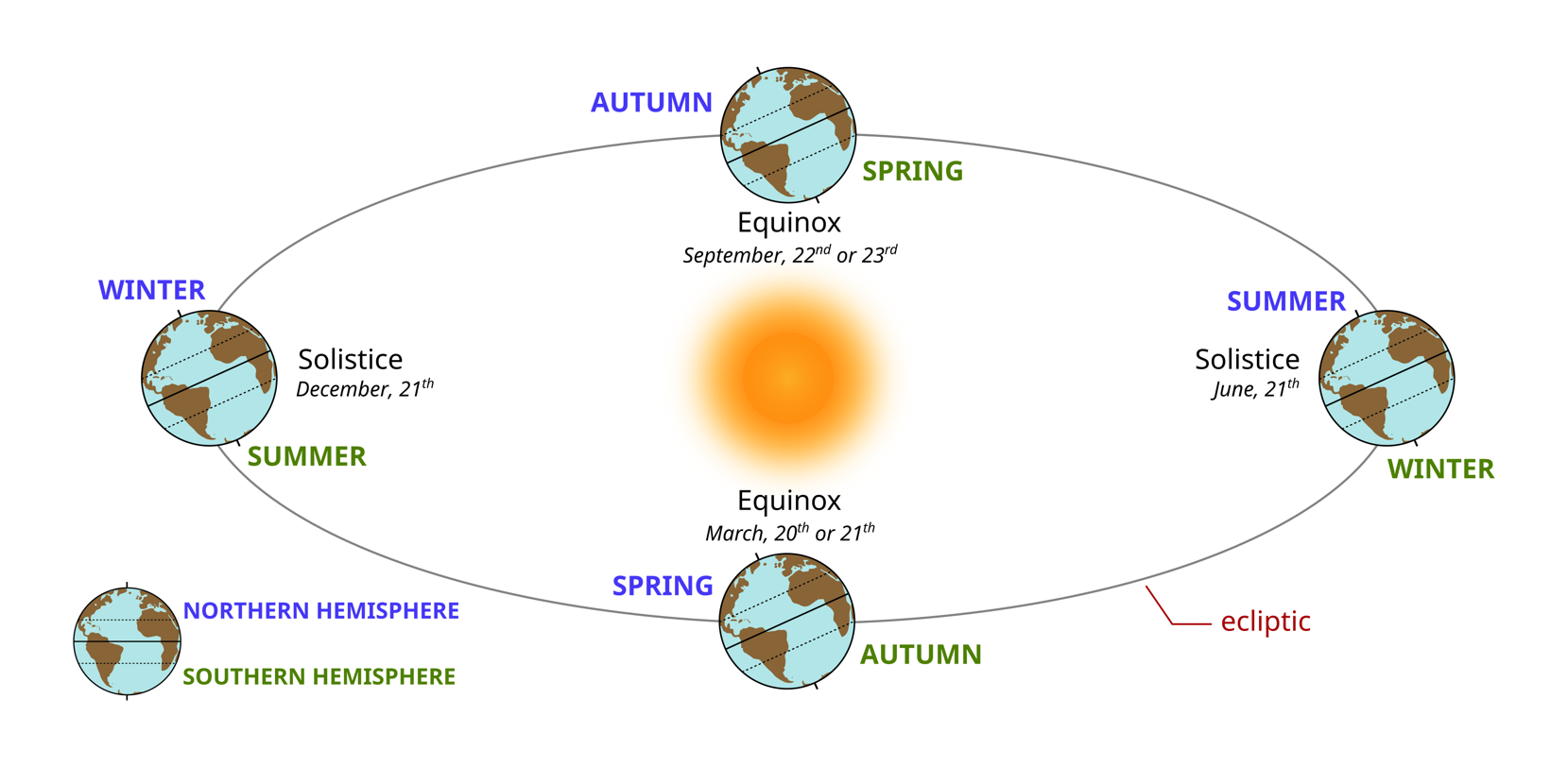
Click on the image to enlarge
Figure 2.1 - Movement of the Earth around the Sun, highlighting the dates of the relevant ephemeris for the Southern Hemisphere.
Source: Martins and Pereira, 2019.
Atmospheric components (gasses and particles present in the atmosphere) also play an important role in the attenuation of solar radiation due to interaction processes such as absorption and scattering of solar radiation. These radiative processes in the atmosphere determine the availability and variability of solar energy incident on the surface, which is used for electricity generation and other purposes.
Understanding solar radiation's daily and seasonal cycles requires defining a series of established concepts based on the relative position between the Sun and the Earth. Among these concepts are the fundamental notable angles illustrated in Figure 2.2: the zenith angle (θz), the altitude or elevation (α), and the solar azimuth angle (γs). The solar declination (δ), illustrated in Figure 2.3, is the angle between an imaginary line joining the Sun's and Earth's centers and the Earth's equatorial plane.
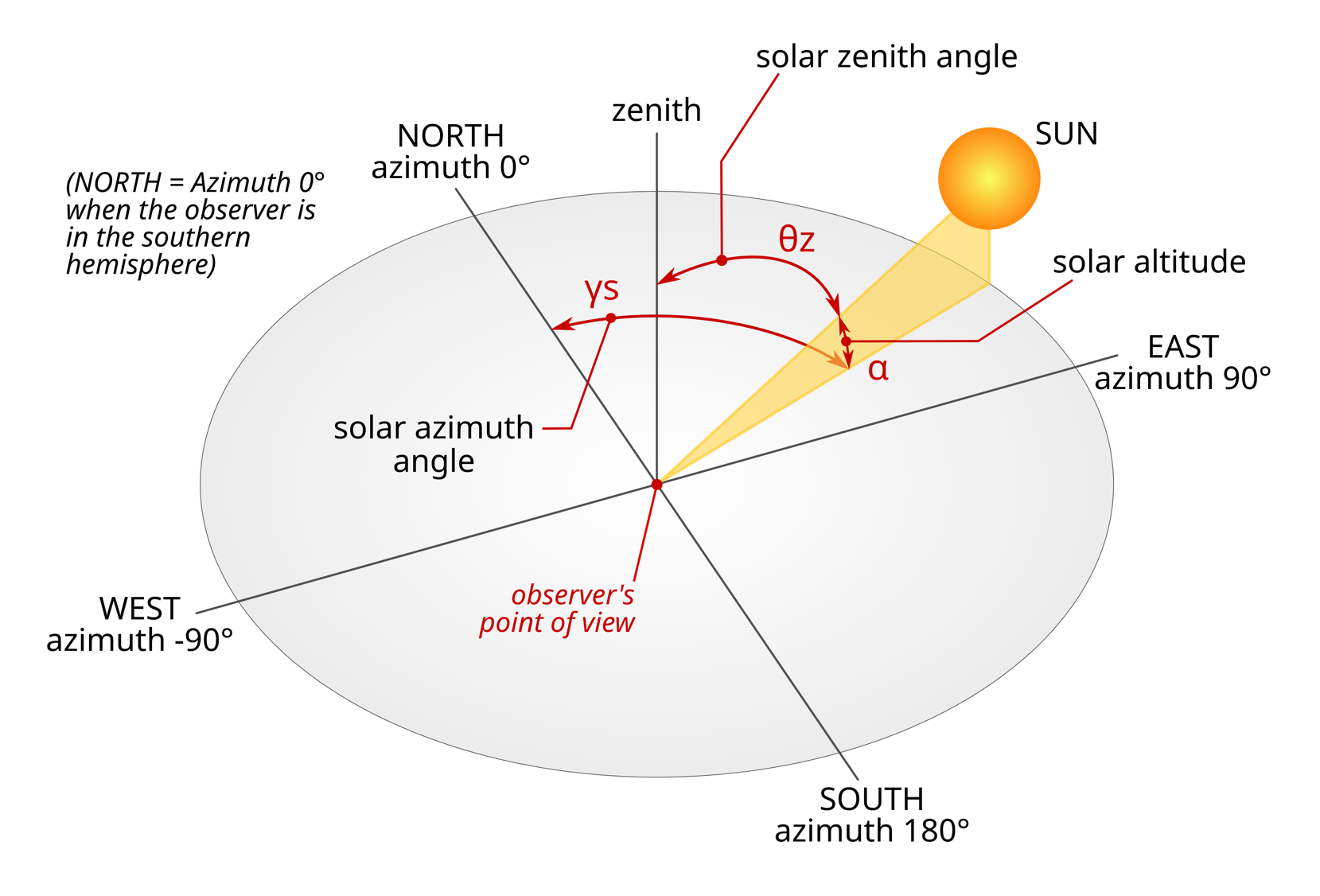
Click on the image to enlarge
Figure 2.2 - Graphic representation of the primary angles that define the position of the Sun in the celestial vault.
Source: Martins and Pereira, 2019.

Click on the image to enlarge
Figure 2.3 - Illustration of the declination angle (δ), which varies from 23.45° north to 23.45° south.
Source: Martins and Pereira, 2019.
Another fundamental concept is the photoperiod, which corresponds to the time interval for the passage of the Sun in the sky, from sunrise to sunset. It gives rise to the concept of twilight as defined by the ABTN standard (NBR-5123), which establishes standards for public lighting.
The Earth's atmosphere acts on the spectrum of incident solar radiation through scattering phenomena and selective absorption at specific wavelengths. Scattering occurs when a fraction of the incident radiation beam is re-radiated at longer wavelengths in random directions. The scattering process depends on the relationship between the atmospheric scatterer component's size distribution and the scattered radiation's wavelength. The scattering caused by atmospheric gases is described as Rayleigh scattering, while the scattering caused by particles suspended in the atmosphere and cloud droplets is described by the Mie scattering theory (Yamasoe & Corrêa, 2016).
Selective absorption of specific wavelengths of solar radiation occurs due to quantum phenomena of interaction between radiation and matter. The atmospheric components that most strongly contribute to the selective absorption of incident solar radiation in the ultraviolet range are ozone (O3), water vapor, and carbon dioxide (CO2) in the visible and near-infrared radiation ranges. As a result of these interactions of solar radiation with the atmosphere, the resulting solar spectrum that reaches the surface is strongly altered, as illustrated in Figure 2.4.
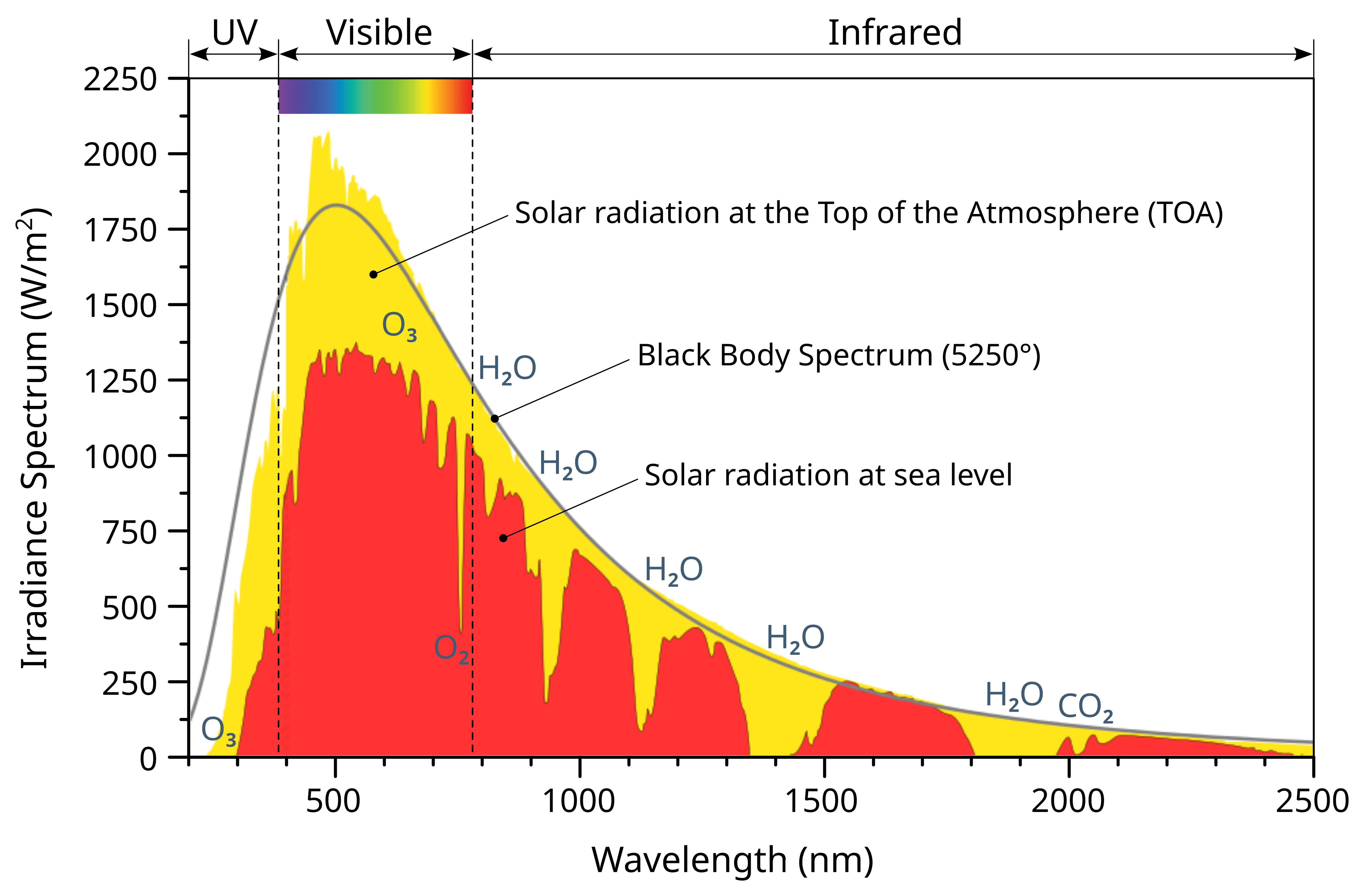
Click on the image to enlarge
Figure 2.4 - The spectrum of solar radiation reaching the top of the atmosphere and the Earth's surface. The plot illustrates the absorption bands and the range of visible radiation.
Solar irradiance represents the instantaneous flux of radiant energy incident on a surface per unit area, expressed in W/m² (Watt per square meter). Solar irradiation represents the amount of energy per unit area reaching the surface. Its unit of measurement in the International System (SI) is J/m² (Joule per square meter). However, the power generation industry most commonly uses the Wh/m² unit (Watt-hour per square meter) to express solar irradiation. This quantity is widely used in sizing photovoltaic systems.
Solar irradiance is classified into Global, Direct, and Diffuse components based on radiative scattering processes in the atmosphere. Solar irradiance can also be determined considering the geometry and location of the surface on which the incidence occurs: Inclined Plane, Horizontal Plane, and Extraterrestrial. Based on these classifications, the definitions adopted in the Solar Energy Atlas of the state of Paraíba are presented below:
The components of solar irradiance can be seen in the Figure 2.5.
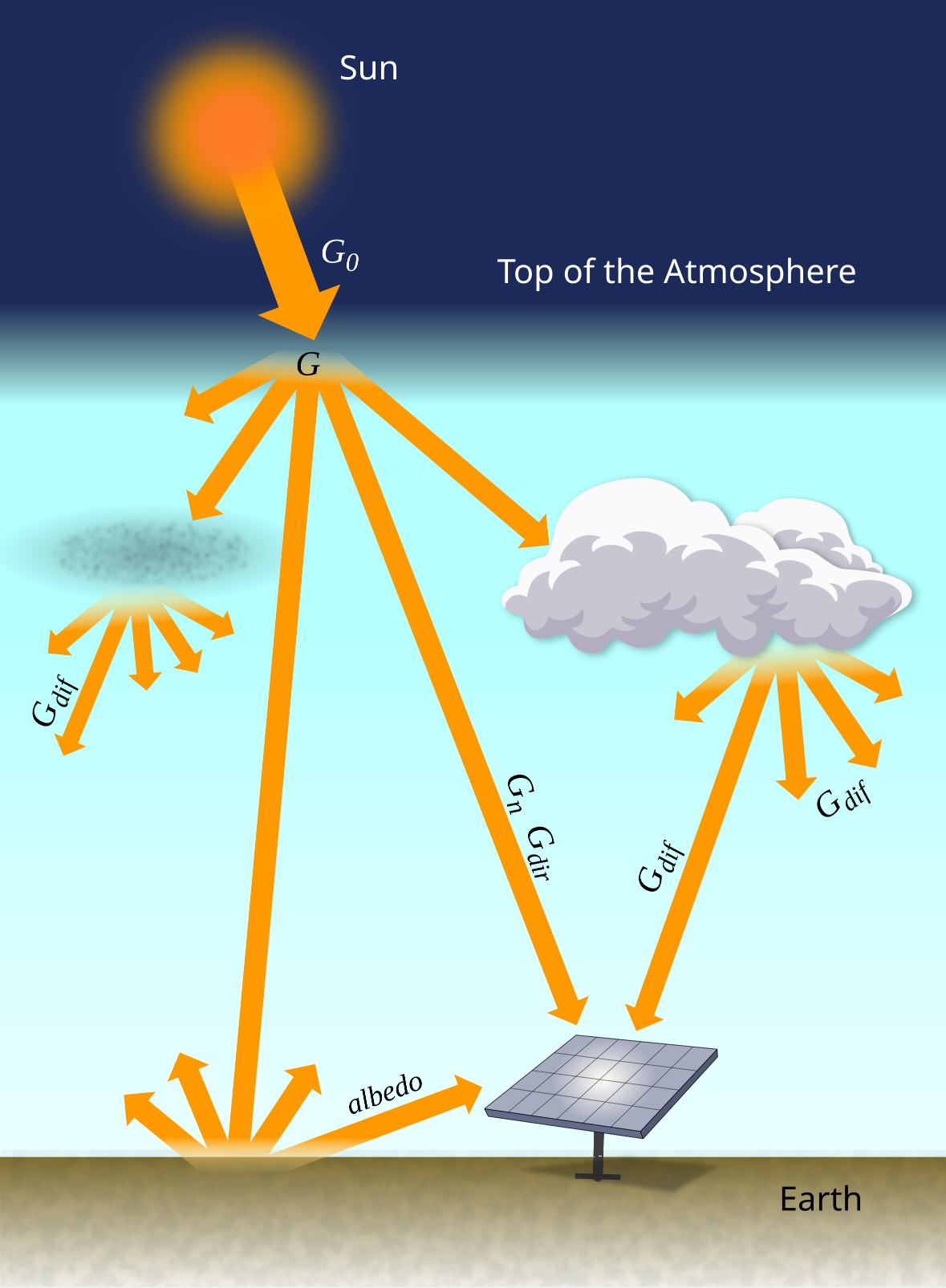
Click on the image to enlarge
Figure 2.5 Components of solar radiation incident on a solar collector in an inclined plane.
Source: Brazilian Solar Energy Atlas - INPE, 2017.
Several methods based on different physical processes are used to measure the solar energy incident on the surface, as shown in Table 2.1. Modern sensors, used to acquire solar radiation data, evaluate the physical parameters measured using an electrical signal and are generically called radiometers. ISO (International Organization for Standardization) and WMO (World Meteorological Organization) standards establish classifications and specifications for measuring solar irradiance (ISO, 1990; WMO, 2008).
Table 2.1 - Main physical processes used for acquiring solar radiation data.

Click on the image to enlarge
Pyranometers are the most recent technology and widely used for global solar irradiance (GHI) measurements. These devices commonly use two types of sensors: the thermopile sensor (set of thermocouples) or the photodiode sensor.
In general, pyranometers are classified into three distinct classes:
Thermopile pyranometers have a practically flat spectral response curve between 300 and 3000 nm (spectral range comprising visible radiation and part of ultraviolet and infrared radiation), which covers the entire solar radiation spectrum of interest, as shown in Figure 2.6. Nowadays, thermopile pyranometers are the most accurate type of radiometers (first class) for measuring solar radiation since the response curve of photodiode radiometers has a high spectral dependence and only partially covers the spectrum of incident solar radiation.
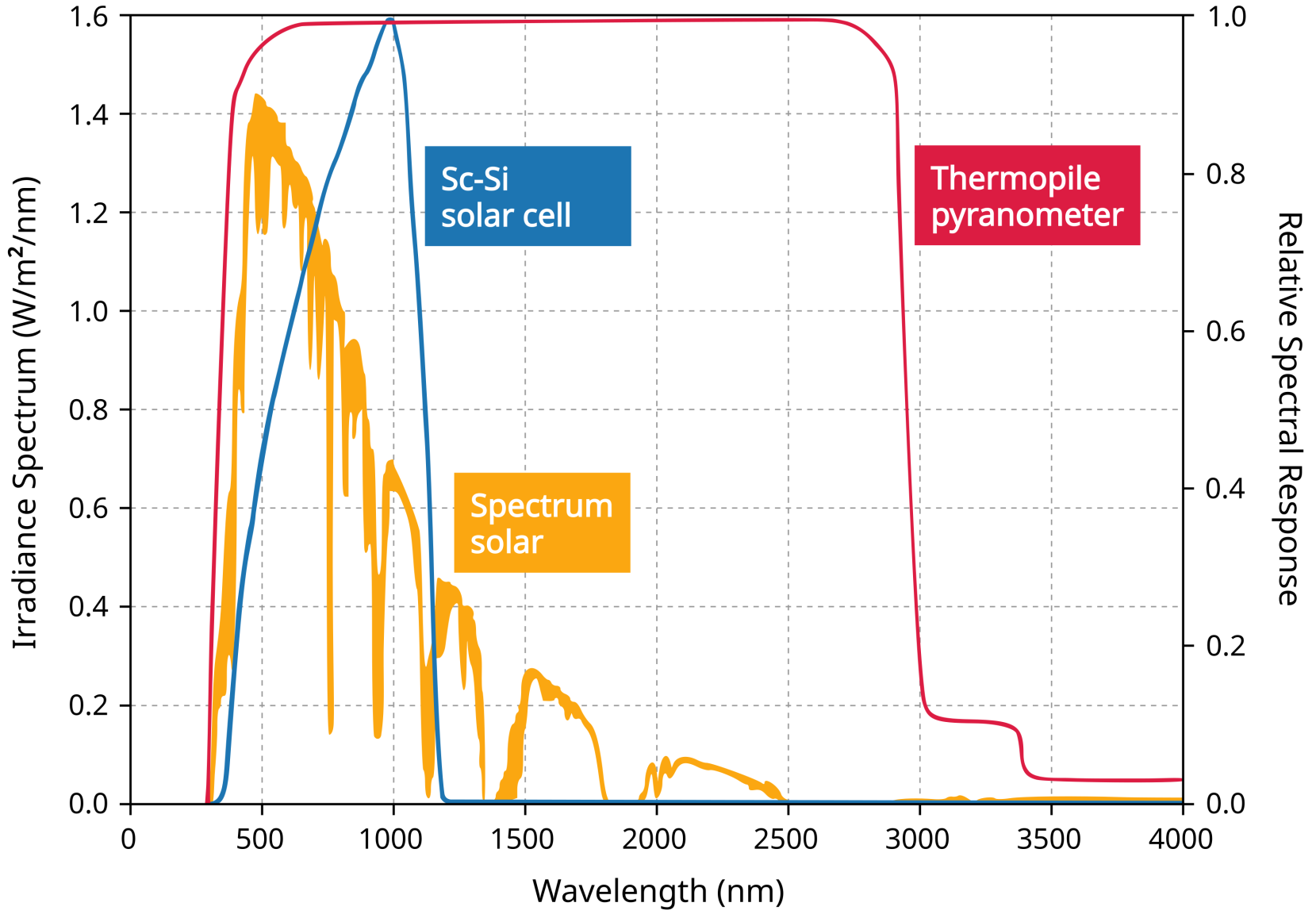
Click on the image to enlarge
Figure 2.6 - Relative spectral responses of a sc-Si solar cell and a thermopile pyranometer.
Source: Neves, 2021.
The direct methodology employs a pyrheliometer, a collimated pyranometer with a thermopile sensing element. A pyrheliometer must be coupled to a robotic system for tracking the solar disk, as shown in Figure 2.7 (a), to keep the sensor always illuminated by solar radiation beam throughout the day.
The indirect methodology uses a pair of pyranometers, one of which must be constantly shaded by using a ring (or a sphere attached to a solar tracker) to measure the diffuse component (DHI) of solar irradiance, as illustrated in Figure 2.7 (b). The direct solar irradiance (Gdir) is obtained by simple subtraction between the global radiation (GHI) and the diffuse component of solar radiation (DHI), and subsequent correction by the solar zenith angle.
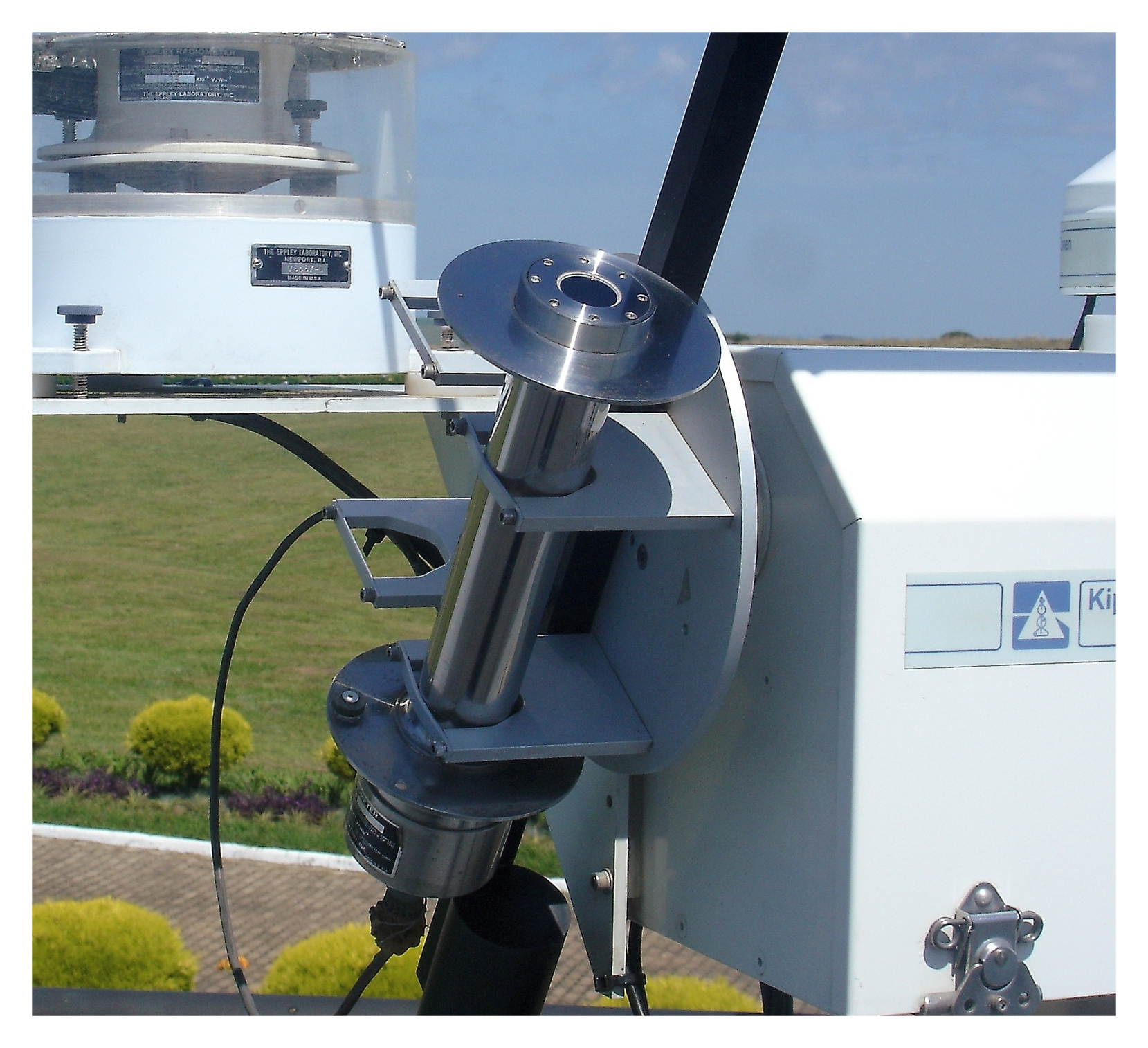
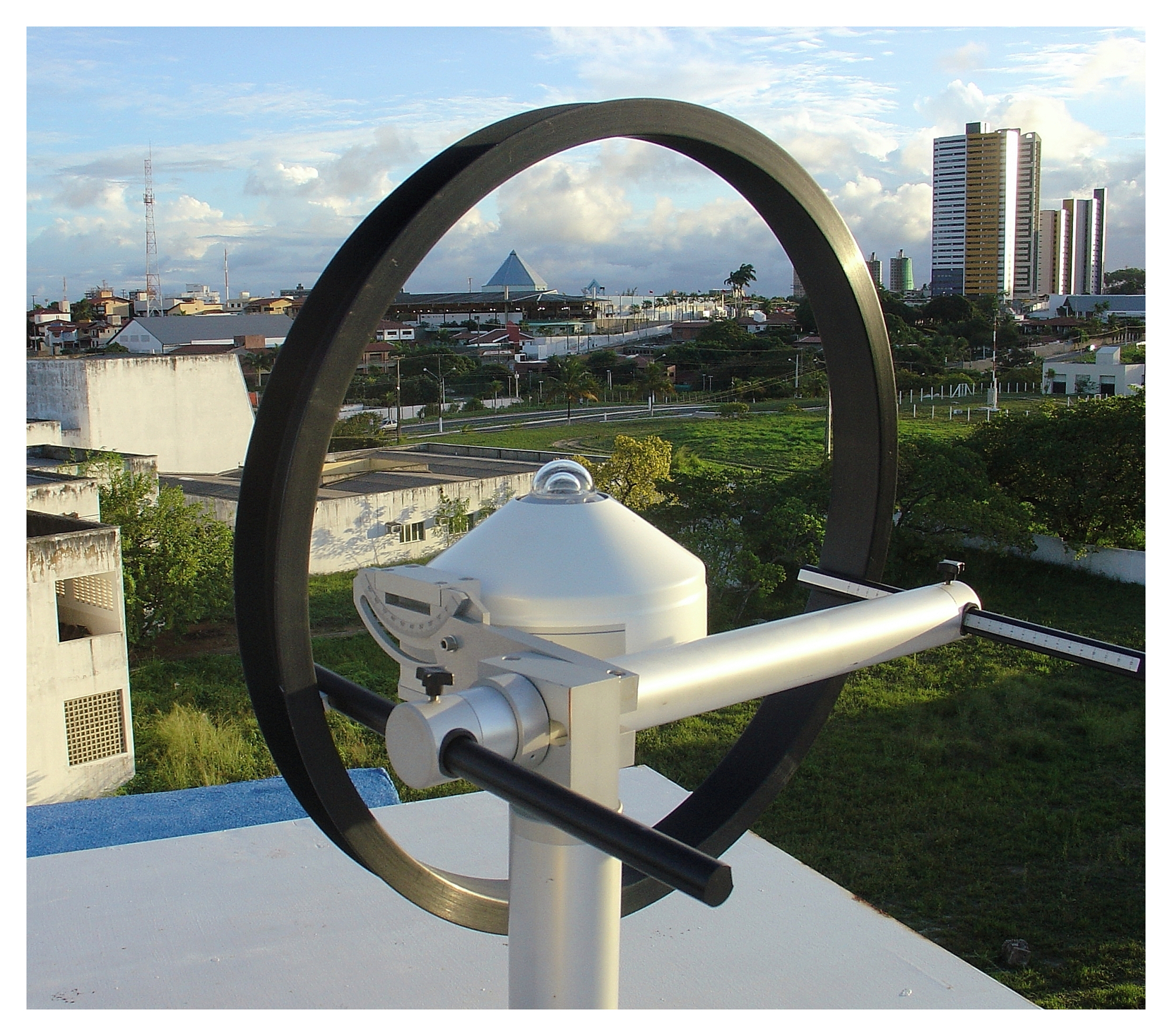
Figure 2.7 - Examples of processes for measuring direct solar radiation: (a) using the pyrheliometer and (b) using a pair of pyranometers, one of which is equipped with a shading ring (the second pyranometer does not appear in the image).
Field measurements of solar irradiance are carried out by solarimetric stations with various configurations. However, to obtain data for solar energy projects, measurements of solar radiation are always accompanied by simultaneous measurements of meteorological variables, such as air temperature and wind speed, at the same data acquisition frequency.
There are two primary types of solarimetric stations: high-quality stations intended for research, development, and calibration of computational models used for surveying solar energy resources and automatic stations defined by EPE (EPE-DEE-RE-065/2013) for data registration and to meet the requirements established for participation in national energy auctions. According to the EPE regulation, the solarimetric station must have at least the following instruments:
The stations destined for research and model development employ, in addition to pyranometers, pyrheliometers coupled to a solar tracker to acquire the direct normal solar irradiance and various other measurement instruments such as sky imaging cameras for evaluating cloudiness, spectrophotometers for studying the spectrum of solar radiation, solar photometers for analyzing the atmosphere composition (aerosols, water vapor), among others. Figure 2.8 illustrates these two types of solarimetric stations.



Figure 2.8 – Solarimetric platforms for data collection (a, b) platform intended for research, (c) platform meeting the EPE requirement (2021).
Uncertainties in solar radiation measurements result from the quality of installations, equipment, the location of measurements, and operational activities in the field. Table 2.2 presents, in a qualitative way, the relative relevance of the various installation, operation, and maintenance stages of a typical solarimetric station. For surveying solar energy resources for electric power generation, "first class" or "secondary standard" instruments should only be used if the project has sufficient long-term financial resources to support the operation and maintenance necessary to ensure the quality of measurements.
Table 2.2 - Relative relevance, in a qualitative way, of the various stages of installation, operation, and maintenance of a solarimetric station.

Click on the image to enlarge
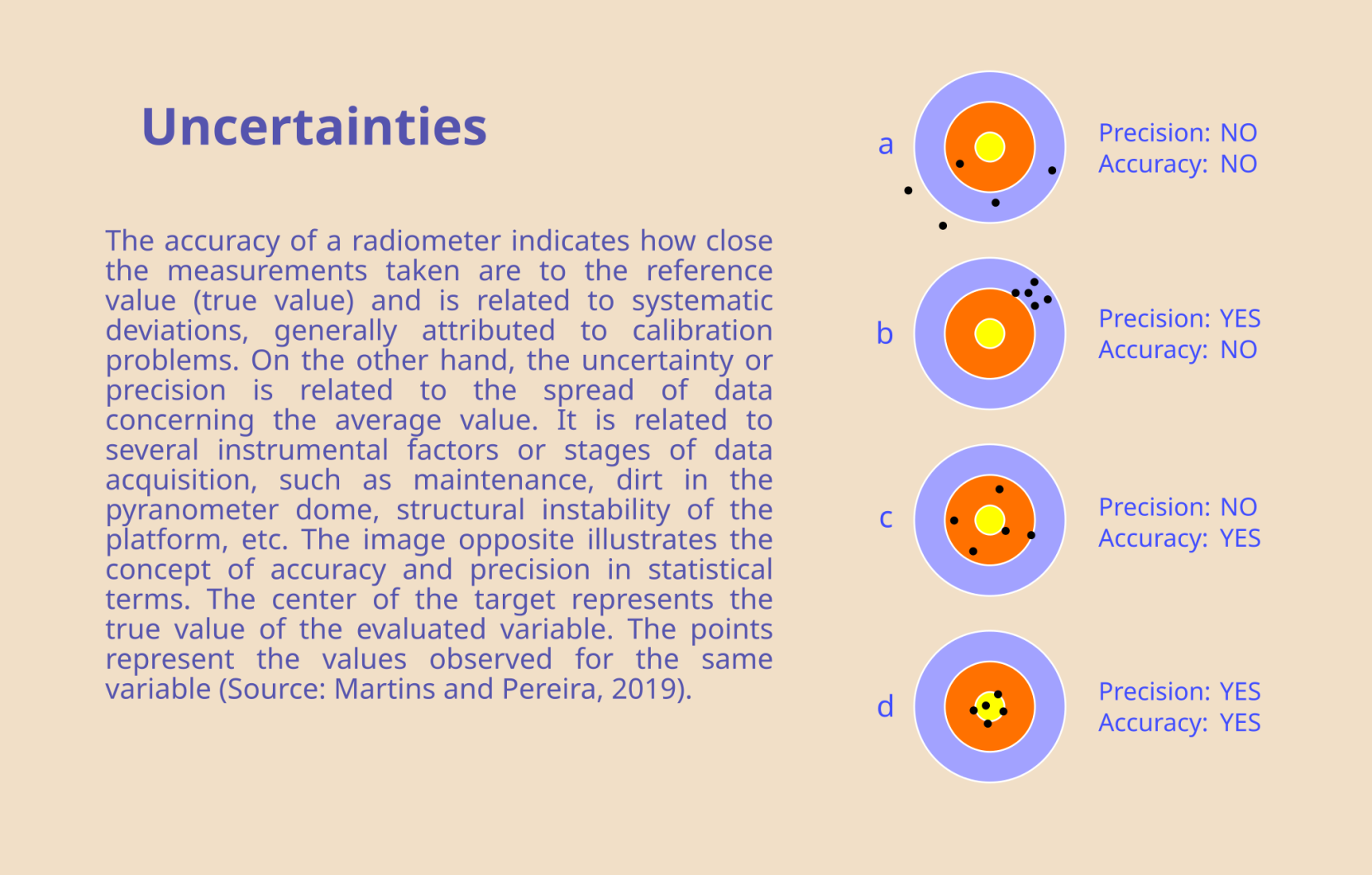
Click on the image to enlarge
Two technologies are used to convert solar energy into electricity: photovoltaic conversion (or photovoltaic generation) and thermal conversion (or heliothermal generation). The first is based on the physical principle known as the photovoltaic effect, which is the production of an electric current in a semiconductor material exposed to electromagnetic radiation, such as the silicon cells present in photovoltaic modules.
Conversion depends on the semiconductor material used, which is characterized by the creation energy of free electron pairs and gaps (forbidden band energy). Thus, the choice of technology for the production of photovoltaic modules (mono- or poly-crystalline silicon, thin films or organic semiconductors) is linked to the spectral response and also to the incident solar spectrum. Figure 2.9 illustrates the photovoltaic effect on a semiconductor cell that makes up a photovoltaic panel. The conversion efficiency of solar radiation into electricity of the technologies available on the market is in the order of 18 to 24%.
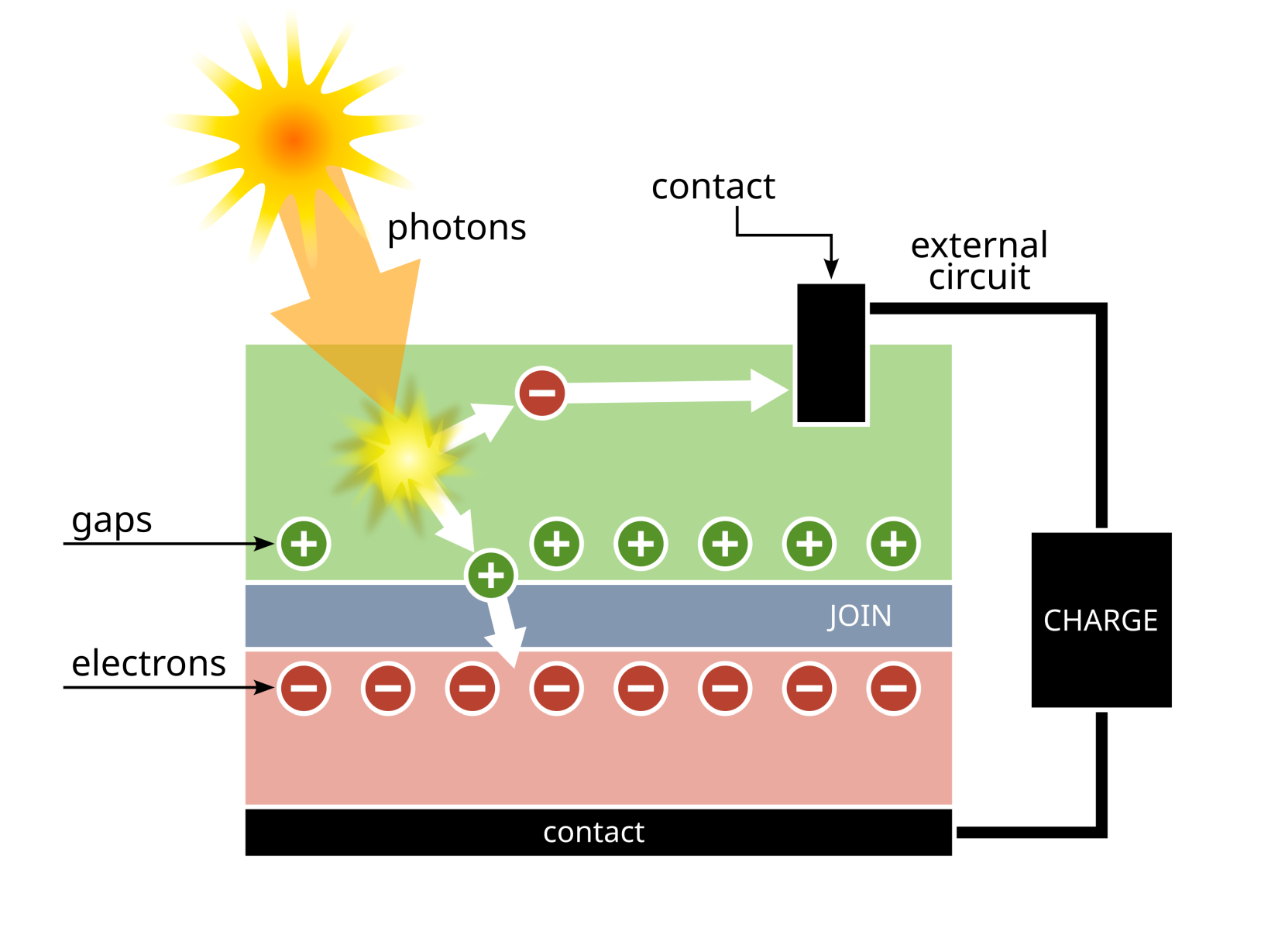
Click on the image to enlarge
Figure 2.9 - Illustration of the photovoltaic effect on a photovoltaic cell.
Source: Neves, 2021.
Photovoltaic generation employs incident global irradiation, that is, both direct and diffuse components of solar radiation, including that due to surface albedo (reflection). Therefore, it occurs even on cloudy days but with lower productivity.
The operating temperature of the semiconductor cell also influences photovoltaic generation. Increasing temperature causes the reduction of photovoltaic conversion efficiency. Hence, the importance of temperature data at the location of the photovoltaic plant, as they influence the operating temperature of the photovoltaic module.
Thermosolar or heliothermic power generation (CSP – Concentrated Solar Power) uses mirrors (heliostats) that reflect sunlight to concentrate the solar beam for thermal conversion. The solar beam heats a working fluid, generating water vapor that moves the turbines, driving the electricity generator. There are several typologies of solar thermal generation, using linear parabolic mirrors or systems of several flat mirrors in an arrangement in order to generate heat at a single point. Figure 2.10 illustrates the main typologies of solar thermal generation most used. Thermal solar generation uses only the direct component of incident solar radiation and, therefore, can only be applied in regions with low cloudiness and high incidence of direct normal solar radiation, such as in arid regions. However, it has the advantage of generating electricity even after sunset, as long as it has storage systems for the heat generated during the day.
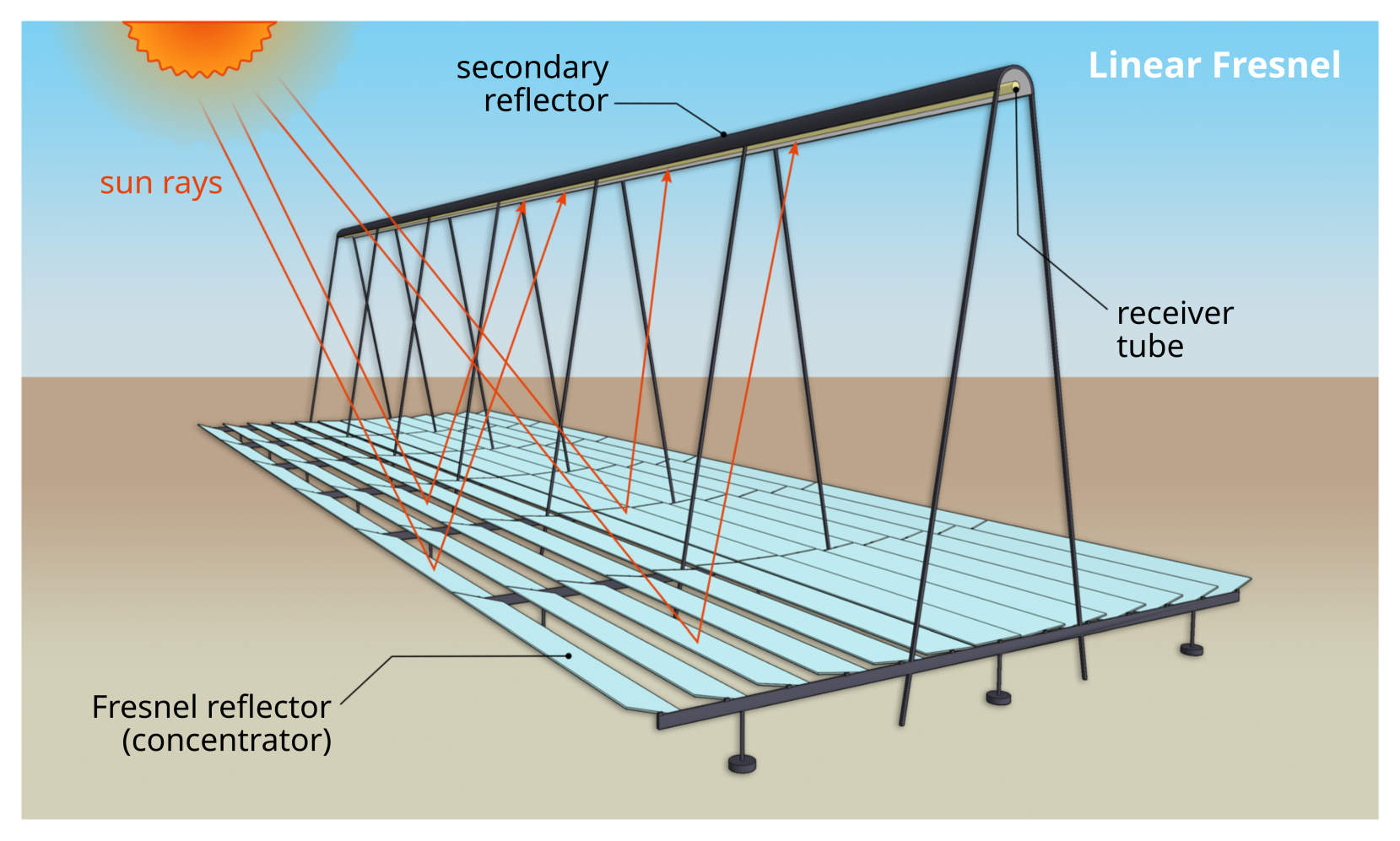
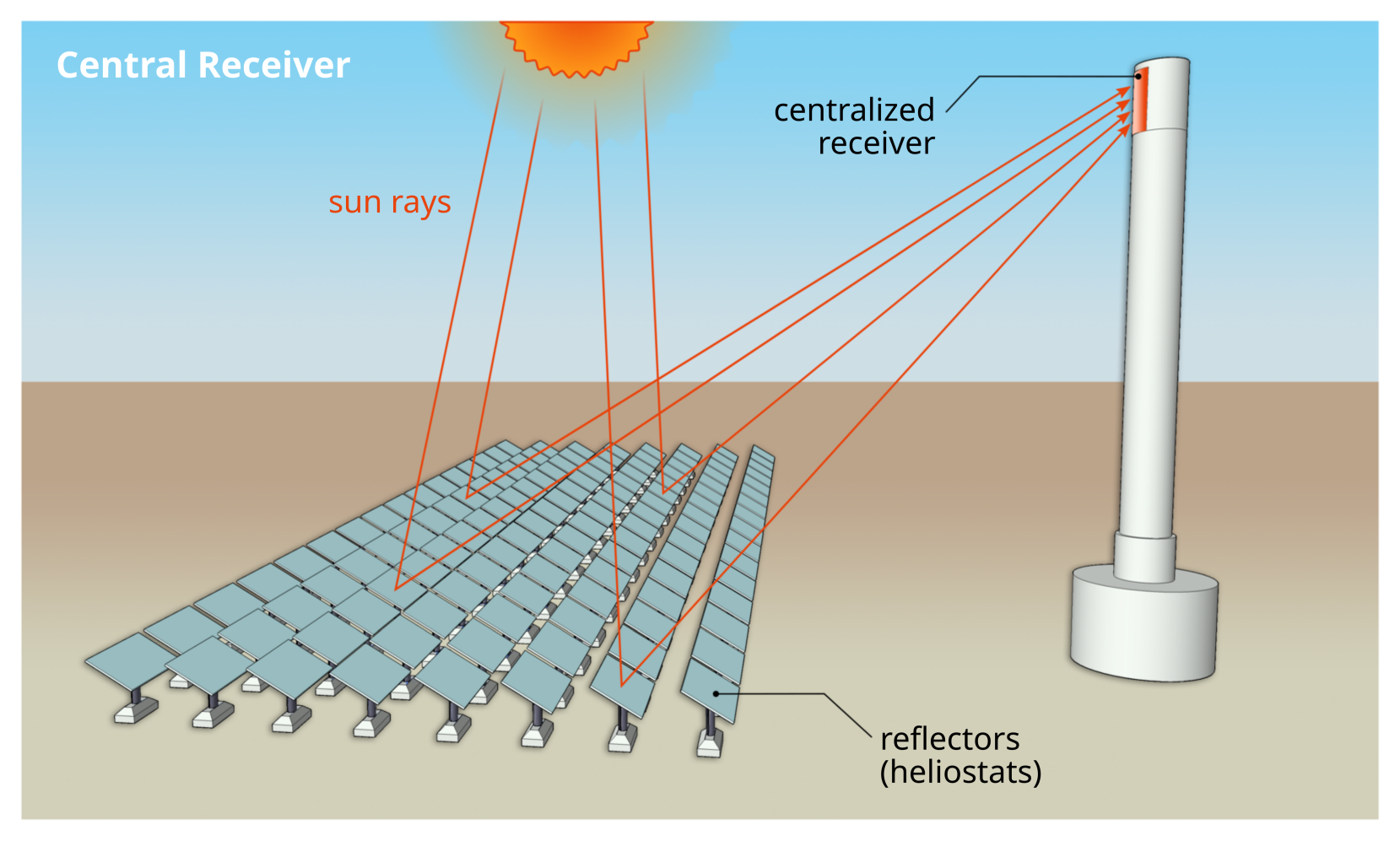


Click on the image to enlarge
Figure 2.10 - (a) heliothermic generation system (a) by Fresnel lens technology (b) employing a tower system; (c) employing parabolic disk; (d) employing parabolic cylinder.